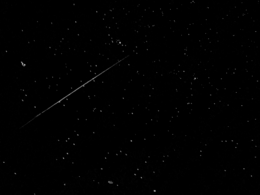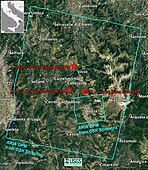COSMO-SkyMed
 A COSMO-SkyMed flare above the UK | |
| Manufacturer | Thales Alenia Space |
|---|---|
| Country of origin | Italy |
| Operator | ASI |
| Applications | Earth observationradar |
| Website | http://www.cosmo-skymed.it/it/index.htm |
| Specifications | |
| Bus | |
| Launch mass | 1,700 kg (3,700 lb)[1] |
| Power | 4 kW |
| Regime | SSO |
| Design life | 5 years |
| Production | |
| Status | Operational |
| On order | 4 |
| Built | 4 |
| Launched | 4 |
| Operational | 4 |
| Maiden launch | COSMO-1 23 June 2007 02:34 UTC |
| Last launch | COSMO-4 5 November 2010 02:20 UTC |
| Manufacturer | Thales Alenia Space |
|---|---|
| Country of origin | Italy |
| Operator | ASI |
| Applications | Earth observationradar |
| Website | http://www.cosmo-skymed.it/it/index.htm |
| Specifications | |
| Bus | |
| Launch mass | 2,230 kg (4,920 lb)[2] |
| Power | 5 kW |
| Regime | SSO |
| Design life | 7 years |
| Production | |
| Status | Operational |
| On order | 2 |
| Built | 2 |
| Launched | 1 |
| Operational | 1 |
| Maiden launch | CSG-1 18 December 2019 08:54 UTC |
COSMO-SkyMed (COnstellation of small Satellites for the Mediterranean basin Observation) is an Earth-observation satellite space-based radar system funded by the Italian Ministry of Research and Ministry of Defence and conducted by the Italian Space Agency (ASI), intended for both military and civilian use.[3] The prime contractor for the spacecraft was Alenia Spazio. COSMO SkyMed is a constellation of four dual use ISR Earth Observation satellites with a synthetic aperture radar as main payload, the result of the intuition of Giorgio Perrotta in the early nineties. The synthetic aperture radar was developed starting in the late nineties with the SAR 2000 program funded by ASI.
The space segment of the system includes four identical medium-sized (1900 kg [4]) satellites called COSMO-SkyMed (or COSMO) 1, 2, 3, 4, equipped with synthetic aperture radar (SAR) sensors with global coverage of the planet.[5] Observations of an area of interest can be repeated several times a day in all-weather conditions. The imagery will be applied to defense and security assurance in Italy and other countries, seismic hazard analysis, environmental disaster monitoring, and agricultural mapping.[6]
Space segment[]
The four satellites are in sun-synchronous polar orbits with a 97.9° inclination at a nominal altitude of 619 km and an orbital period of 97.2 minutes. The local time ascending node at the equator is 06:00. The operating life of each satellite is estimated to be 5 years. Each satellite repeats the same ground track every 16 days. They cross the equator at approximately 06:00 and 18:00 local-time each day and can image any point twice each day. The satellites are phased in the same orbital plane, with COSMO-SkyMed's 1, 3, and 2 at 90° intervals followed by COSMO-SkyMed 4 at 67.5° after COSMO-SkyMed 2. The offset of satellite 4 allows a one-day interferometry mode for elevation information.[7] The sun-synchronous orbit is used due to power (Electrical Power Subsystem ) and revisit time requirements.
The satellites' main components are:
- Two solar arrays for 3.8 kW at 42 V DC.
- Stabilization, navigation and GPS systems.
- Synthetic-aperture radar working in X-band.
- 300 Gbit on-board memory and 310 Mbit/s data-link with ground segments.
The radar antenna is a phased array that is 1.4 m wide x 5.7 m long. The system is capable of both single- and dual-polarization collection. The center frequency is 9.6 GHz with a maximum radar bandwidth of 400 MHz.[8]
Launch[]
United Launch Alliance provided launch services for the satellites with their Delta II 7420-10C rockets from Vandenberg Air Force Base.[9] Satellite processing for the first two satellites was handled by the Astrotech Space Operations subsidiary of SPACEHAB.[6] The first satellite COSMO-1 (COSPAR 2007-023A) was launched at 02:34 UTC on 8 June 2007.[10] COSMO-2 (COSPAR 2007-059A) was launched at 02:31:42 UTC on 9 December 2007,[11] the launch having been delayed from 6 December 2007 due to bad weather, and problems with the rocket's cork insulation. COSMO-3 (COSPAR 2008-054A) launched at 02:28 UTC on 25 October 2008. COSMO-4 (COSPAR 2010-060A) launched on 6 November 2010 02:20 UTC.[4]
Ground segment[]
The ground segment of the system is composed of:
- Command Center:
- User Ground Segments:
The Argentinian and the French governments are involved respectively in the civil and military segments of the system.
SAR capabilities[]
The COSMO-SkyMed satellites have three basic types of imaging modes:
- Spotlight, a high-resolution mode collected over a small area by steering the radar beam slightly fore-to-aft during the collection period.
- Stripmap, a medium-resolution mode collected over long, continuous swaths in which the beam is pointed broadside to the satellite track.
- ScanSAR, a low-resolution mode that creates extra-wide swaths by collecting short segments at different ranges and then mosaicking them together.
There are two Spotlight modes:
- SPOTLIGHT1, which is a military-only mode, and
- SPOTLIGHT2, which provides a resolution of 1 m over a 10 x 10 km area. Spotlight polarization is limited to either HH or VV.
There are two Stripmap modes:
- HIMAGE, which provides a resolution of between 3 and 5 m over a swath of 40 km, and
- PINGPONG, which collects dual-polarization data at 15 m resolution over a swath of 30 km. The dual-polarization data can consist of any two polarizations (HH, VV, VH, HV), and it is non-coherent, as it is collected in "pulse groups" that alternate from one polarization to the other.
There are two ScanSAR modes:
- WIDEREGION, which provides 30 m resolution data over a swath of 100 km, and
- HUGEREGION, which provides 100 m resolution data over a swath of 200 km.
The system is sized to collect up to 450 images per satellite per day.[12]

Overview of Damage Proxy Map from COSMO-SkyMed data

View of Norcia before October 2016 Central Italy earthquakes

View of Norcia after October 2016 Central Italy earthquakes
Commercialization[]
, a joint venture between European spaceflight services company Telespazio and the Italian Space Agency (ASI), has the exclusive worldwide commercial rights to sell COSMO-SkyMed data and products.[13][12]
Flares[]
The COSMO-SkyMed satellites are lesser-known deliverers of satellite flares, sometimes approaching magnitude −3. Flares come mainly from SAR-panels of the satellites. Although overshadowed by the Iridium satellites, the flares are often long-lasting, with the satellites traversing much of the sky at brighter-than-average magnitudes.
COSMO-SkyMed second generation, CSG[]
To replace the first COSMO-SkyMed constellation, the Italian Space Agency is developing the COSMO-SkyMed 2nd generation constellation. The 2nd generation constellation has the same function of radar-based Earth observation with particular focus on the Mediterranean area as the 1st generation. The main difference from 1st generation is that the 2nd generation consists of only 2 satellites, CSG-1 and CSG-2. The satellites are improved versions of the first generation satellites. Also the radar payload CSG-SAR (COSMO-SkyMed Second Generation Synthetic Aperture Radar) is an improved version of the first generation X-band SAR payload. Furthermore, the 2nd generation satellites will operate in the same orbit (indeed, in the same orbital plane) as the first generation satellites. The 2nd generation satellites slightly outweigh the first generation satellites at 2230 kg mass.[14]
The contract for building the satellites was signed in September 2015. The satellites are built by Thales Alenia Space (the successor company of Alenia Spazio). They have a planned lifetime of 7 years. CSG 1 was launched 18 December 2019 by Soyuz ST-A from Centre spatial Guyanais. As of October 2020, CSG 2 satellite targets launch for October 2020.[15]
See also[]
- SAOCOM, two Argentine SAR-satellites that are part of the SIASGE constellation alongside COSMO-SkyMed.
- SAR Lupe, a system of five military SAR-satellites of Germany.
References[]
- ^ "COSMO-SkyMed (Constellation of 4 SAR Satellites)". eoportal.org. Retrieved 26 November 2020.
- ^ "COSMO-SkyMed Second Generation (CSG) Constellation". eoportal.org. Retrieved 26 November 2020.
- ^ "COSMO-SkyMed: Mission definition and main applications and products" (PDF). ESA.
- ^ Jump up to: a b https://space.skyrocket.de/doc_sdat/cosmo-skymed-1.htm
- ^ "COSMO-SkyMed". Telespazio. Archived from the original on 8 July 2007.
- ^ Jump up to: a b "SPACEHAB Subsidiary Signs New Contracts Totaling US$4.7 million". SPACEHAB.
- ^ "COSMO-SkyMed Mission and Products Description 23/01/2019". e-geos. Italian Space Agency. Retrieved 24 August 2020.
- ^ "COSMO-SkyMed User Guide" (PDF). ASI.
- ^ "Boeing To Launch Fourth EO Satellite For Italy". SpaceDaily. 23 December 2008.
- ^ "Worldwide launch schedule". Spaceflight Now. Archived from the original on 11 September 2013.
- ^ NASA Spaceflight.com – Delta II launches with COSMO-SkyMed-2 Archived 8 December 2007 at the Wayback Machine
- ^ Jump up to: a b "eGEOS: COSMO-SkyMed Overview". eGEOS.(subscription required)
- ^ "E-GEOS to Create Early Warning System for Caribbean Weather Emergencies". satellitetoday.com. 18 December 2018. Retrieved 23 August 2019.
- ^ https://space.skyrocket.de/doc_sdat/cosmo-skymed-csg.htm
- ^ "Index satellite CEOS - ASE". 10 October 2020. Retrieved 10 October 2020.
External links[]
| Wikimedia Commons has media related to COSMO-SkyMed. |
- COSMO-SkyMed Web Site
- COSMO-SkyMed Products
- INNOVA Consorzio per l'Informatica e la Telematica s.r.l. – Italian SME with specific know-how and expertise with COSMO-SkyMed's HDF5 format
- Remote Monitoring of Migrants Vessels in the Mediterranean Sea (CeMiSS) File pdf
- Spacecraft launched in 2019
- 2019 in Italy
- Satellites of Italy
- Synthetic aperture radar satellites
- Satellite constellations
- Military equipment introduced in the 2000s



